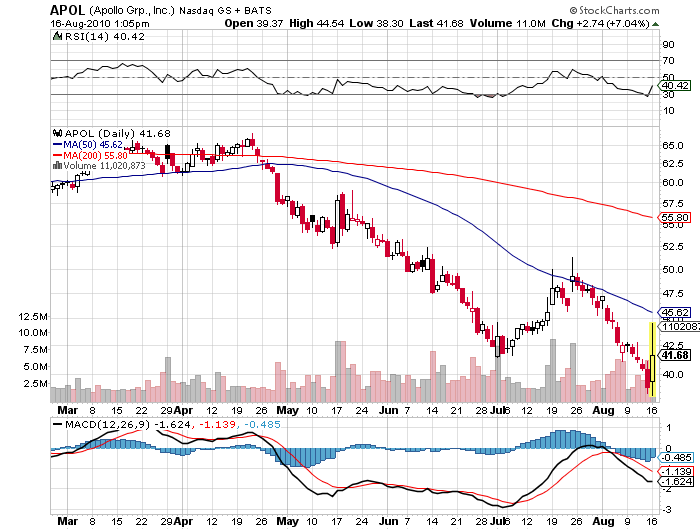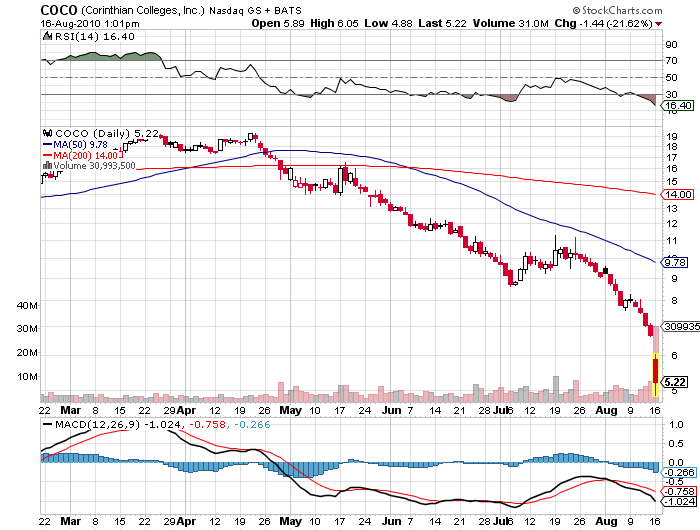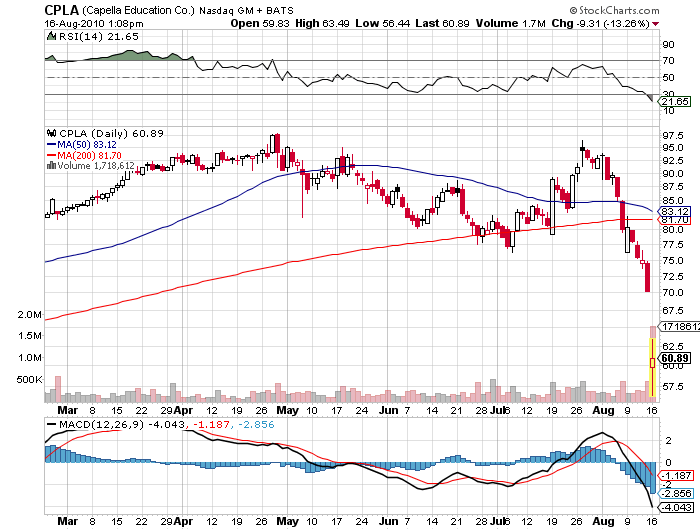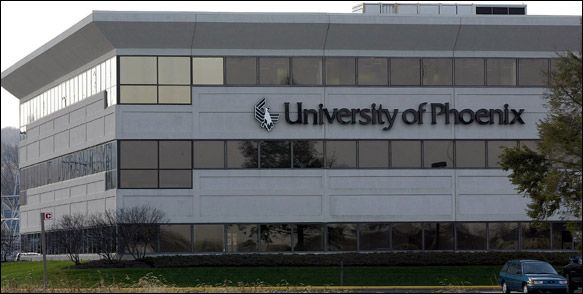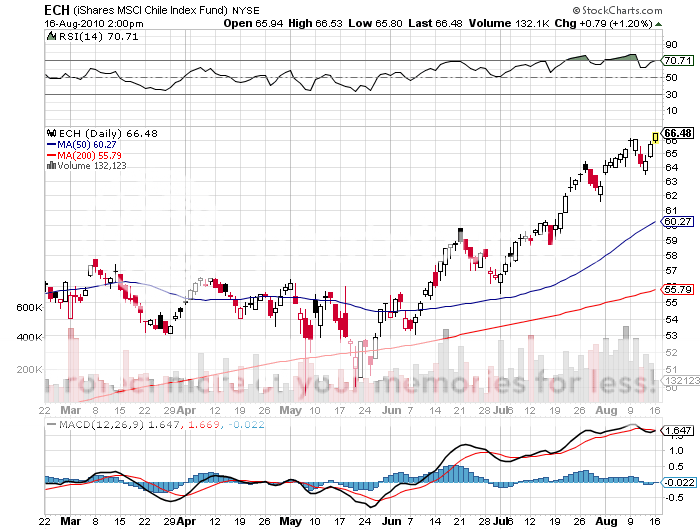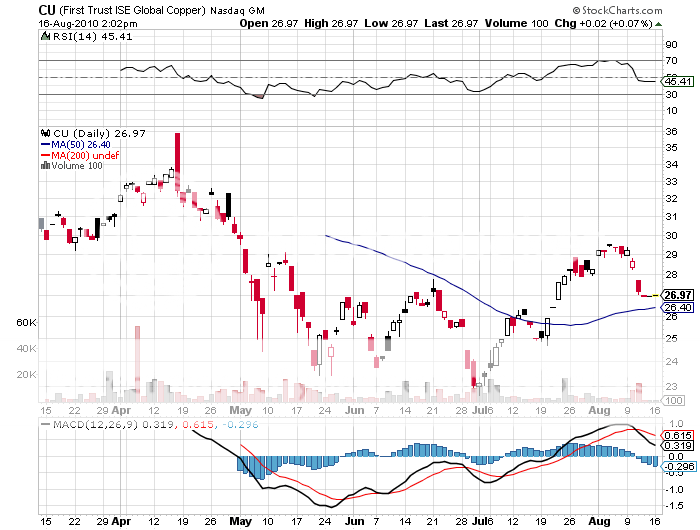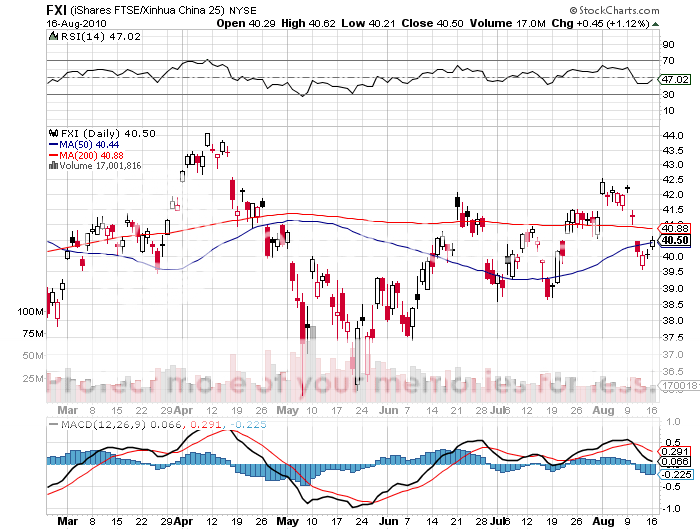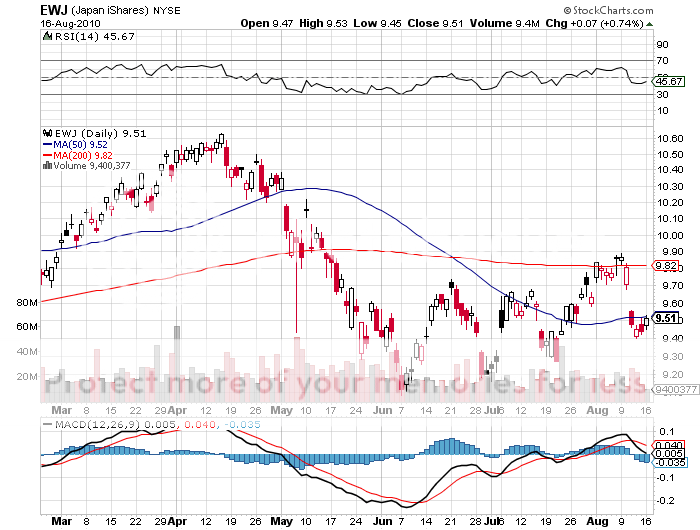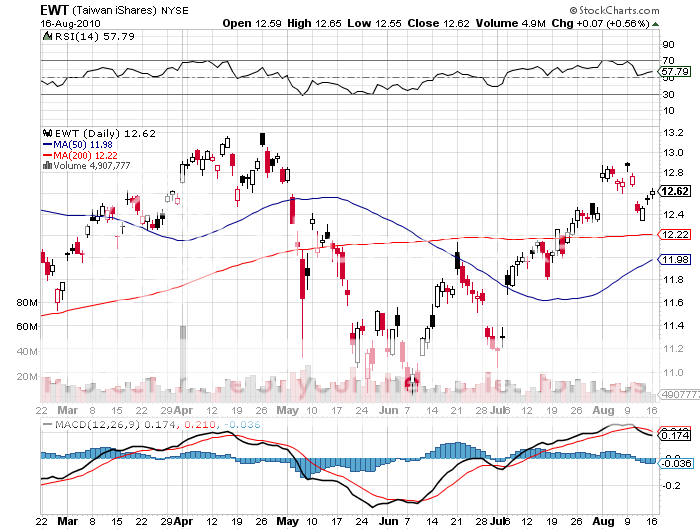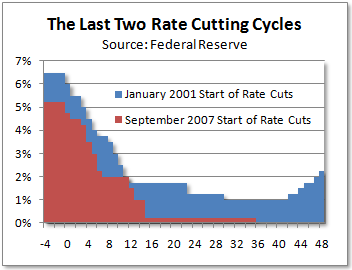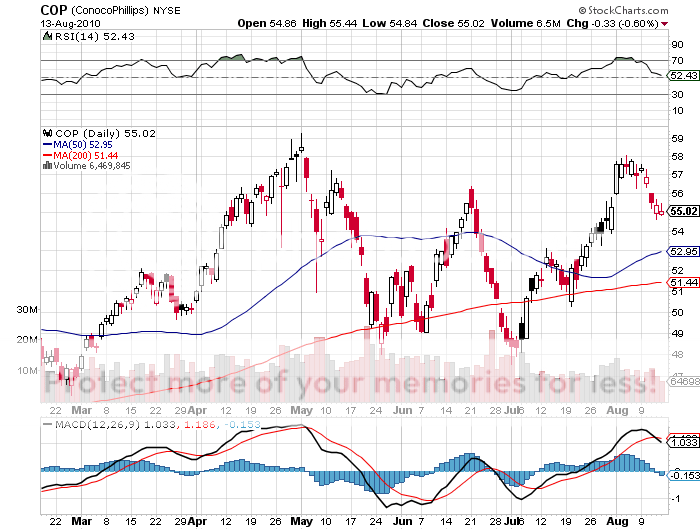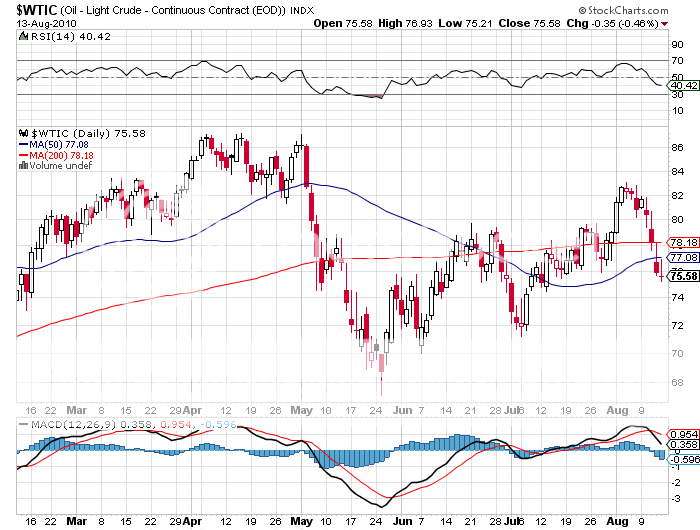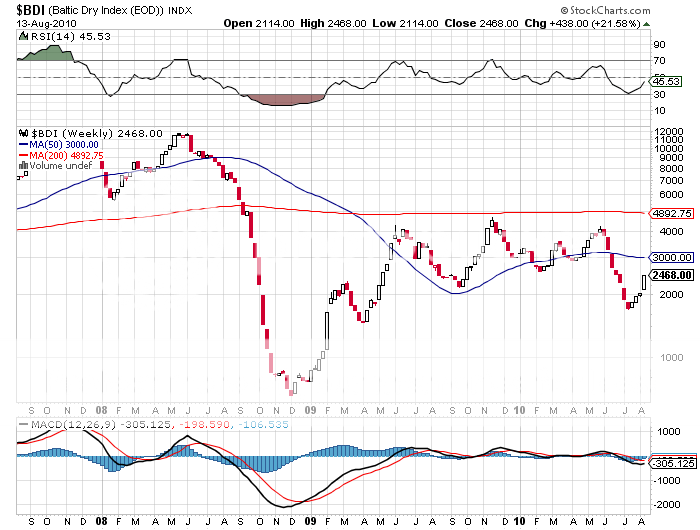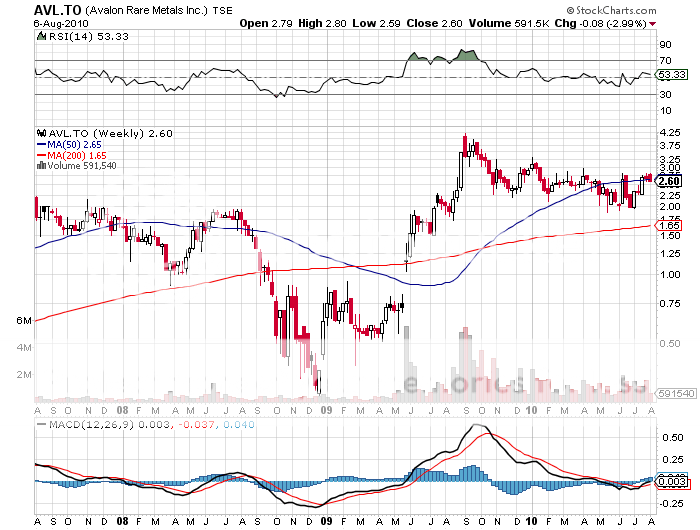
'Bull markets are born on pessimism, grow on skepticism, mature on optimism, and they die on euphoria,' said my late friend, Sir John Templeton, over lunch at his home at Lyford Cay in the Bahamas.
Featured Trades: (FOR PROFIT EDUCATION),
(APOL), (DV), (CPLA), (COCO), (STRA),
1) For Profit Education Jumps From the Frying Pan to the Fire. On Friday, the Department of Education released data showing that the student loan repayment rate at some schools was as low as 25%, and that it would take action to disqualify these schools for future student loans. That amounts to the taking away the punch bowl from a highly leveraged, overpriced industry, a hedge fund manager's dream come true. This is turning into a major home run for those who took my advice to sell the sector on June 2 (See 'Hedge Funds Target for Profit Education' by clicking here, and my follow up "The Smoking Gun on For-Profit Education" by clicking here). I knew I was on to a great trade here because of the torrent of emails I received from these schools threatening litigation or worse. For profit schools have made a killing from naive aspiring students taking out $5 billion in Pell grants and $20 billion in federal subsidized loans. A few weeks after my initial report, the General Accounting Office reported the results of an undercover investigation showing widespread fraud and abuse in the sector, with some financial aid officers advising students to lie on their applications. Today was the day when the chickens came home to roost. Since my call, lead stock Apollo Group (APOL) of University of Phoenix fame has fallen 27%, DeVry (DV) 33%, and Capella Education (CPLA) 35%. Those who cast a wider net caught Corinthian Colleges (COCO) down a spectacular 62% and Strayer Education down 30%. The management of Strayer said they where shocked, shocked that repayment rates were so low, as Claude Raines might have said in the classic film, Casablanca. I've had some friends get their eyes ripped out by these guys through running up $50,000 in debt to obtain useless degrees, so this couldn't be happening to a nicer bunch of people. Although these stocks have already gone down a lot, there may be more to go. It is safe to say that the Obama administration hates these predatory schools, and that criminal prosecutions are certain to follow. Still, if you prefer to sleep at night, you might want to book some profits now.
I'm Shocked, Shocked, That
Student Loan Repayment Rates Are So Low!
Featured Trades: (CHILE), (ECH), (CU)
iShares MSCI Chile Index Fund ETF
First Trust ISE Global Copper ETF
2) Why Can't We Be More Like Chile? I just want to pass on some data forwarded to me from my extensive band of Chilean readers in response to my recent piece, 'Chile is Looking Hot' (click here for the piece). In 2007, the government dissolved the old Copper Stabilization Fund and rolled windfall profits from sales of the red metal into a sovereign wealth fund called the Economic and Social Stabilization Fund. Today that fund has $11.7 billion, a lot for a small country like Chile, which only has a GDP of $161 billion and a population of 17 million. The fund will be used to increase government spending during economic downturns, thus eliminating the need for any borrowing during times of distress. This is one of the reasons why the Chilean ETF (ECH) never sold off in the wake of the massive 8.8 magnitude earthquake that struck in February. I had hoped to use the natural disaster to gain a good entry point to the country, to no avail. Imagine that! Counter cyclical Keynesian spending financed out of savings, instead of debt. Too bad they didn't think about that here! If I've piqued your fancy, another way to play Chile is to buy the copper industry ETF (CU), which has extensive holdings in this incredible well managed country. Since I recommended Chile only two weeks ago, the ETF has risen by 5% during otherwise dismal global trading conditions. And my American Chilean readers, who thank the heavens the day they decided to retire there, also recommend long positions in the country's outstanding wines, including a mature Viva Almaviva, a Carmin de Peumo, and a Viva Concha y Toro.
Featured Trades: (CHINA), (TAIWAN), (JAPAN), (FXI), (EWJ), (EWT)
iShares FTSE/Xinhua China 25
Japan iShares ETF
Taiwan iShares ETF
3) It's Official: China is Number Two. With China's (FXI) economy rocketing at 8%-13% quarterly growth rates, and Japan (EWJ) plodding away with meager 1%-2% rates, it was only a matter of time before the Middle Kingdom bumped the Land of the Rising Sun from its number two position in national GDP rankings. Chinese officials will be quick to point out that, according to IMF figures, their $3,600 per capita nominal GDP still qualifies them for emerging market status, compared to $39,731 for Japan, $46,381 in the US, and an amazing $104, 512 for Luxembourg. It is highly unlikely that China's standard of living will ever approach that of the US, although it will narrow the gap, possibly rising to $20,000 over the next 20 years in today's dollars. One country that might pull this off is?? Taiwan (EWT), which offers investors a way to play China though the back door, and already has a per capital GDP of $16,392. China bumped its errant, breakaway province closer to achieving this last week when its Taiwan Affairs Office said it will honor Taiwan's bilateral trade agreements for the first time. One is already in the works with Singapore, and deals with others in the Asian region are expected to follow.
Japan is Not Carrying Its Weight Any More
Featured Trades: (CNBC SPOOF)
4) Trashing CNBC on a Slow Day. With trading volume dropping through the floor the market has gotten so boring that I have run out of things to write about. So I can either pump out a mediocre piece of crap that you will probably lose money on, like the other newsletters do, or I can give you something frivolous and useless, but really funny. I vote for the latter. Below find a link to a YouTube video of a bizarre spoof of CNBC listing the countless shortcomings of its personalities, as seen in an imaginary interview between Larry King and Sarah Palin. My apologies in advance to Bob Pisani, Rick Santelli, Erin Burnett, Mark Haines, Trish Regan, Melissa Francis, Jim Cramer, Larry Kudlow, Sue Herera, John Maynard Keynes, and Michelle Caruso-Cabrera's breasts. Yes, I know, don't shoot the messenger. And don't miss the shameless plug for Zero Hedge at the end. Hurry up and watch it before the libel lawyers take it down. Here it is at http://www.youtube.com/watch?v=T9CEqhmU0Pg
'A slave with three masters is a free man,' said guru, Peter F. Drucker, in his classic tome on management, The Essential Drucker.
Featured Trades: (QUANTITATIVE EASING)
1) The Fed Makes Its Move. Man, I go on vacation of a couple of days and the world turns upside down. I'm talking about the arrival of the QE II. No, I'm not talking about the docking of a new cruise ship, or even the ruling member of the House of Windsor. It's round two of quantitative easing I'm referring to, the Federal Reserve's attempt to head off a double dip recession by flooding the system with liquidity. After watching retail sales shrivel, the housing market roll over for dead, again, and unemployment tenaciously flirting with double digits, Bernanke & Co. are admitting that there might just be a little problem with the economy. As far as the markets are concerned, he might as well have pulled the fire alarm, hit the panic button, and set off distress flares. Of course, avid readers of this letter have been aware of this scenario since January, when I predicted a 'square root' shaped recovery, generating growth that is feeble at best at 2.0%-2.5% (click here for the call). This is why I have avoided equities like a new form of venereal disease all year, except for the rifle shots in technology, energy, commodities, precious metals, and a few special situations. Too bad I didn't reach the second derivative conclusion earlier that this would cause bond prices to fly. After seeing optimism shoot to the upside in Q1, we shall see pessimism over do it on the downside in Q3. PIMCO's BSD, Mohamed El-Erian, is talking about a 25% probability of a double dip, while Yale economist Robert Shiller sees a 50:50 chance. The upcoming November election promises to muddle the picture further in coming months. The crystal clear waters of Lake Tahoe beckon. Maybe I should take a second summer vacation this year.
Can QE 2 Save Our Economy?
Featured Trades: (COP), (BP), (OIL)
2) ConocoPhillips Looks Like a Steal. Since I am a permabull on energy of all types, I am constantly trolling the markets for cheap energy plays, and ConocoPhillips (COP) popped up on my radar. The large cap integrated oil major has announced a $20 billion restructuring that has whetted my appetite. Specifically, they are allocating $10 billion to retire debt and a further $10 billion to buy back their own stock. With a PE multiple of 8.5 X and a dividend yield of 4%, some 1.3% higher than ten year Treasury bonds, you can hardly blame them. COP has long been a favorite of Oracle of Omaha, Warren Buffet, (click here for the tip). Bring them back to their peer group valuation, and that takes the stock up to $75, some 36% higher from here. I'm not the only hedge fund manager looking for these kinds of plays, which is why I was able to grab a quick 38% profit in British Petroleum (BP) in a matter of weeks (click here for the call). Look at the chart and try to buy at the bottom end of its recent range. It's nice to have some insurance for that day you know is coming when you wake up and find oil suddenly up $10 because of some unexpected shenanigans in the Middle East.
Waking up to ConocoPhillips
Featured Trades: (SHIPPING), (TK), (NAT), (OSG), (FRO)
3) Pick Up Shipping Stocks for the Dividend. The markets are currently stampeding for yield of any description, damn the risk. That's why shipping stocks have suddenly come into focus, which offer some of the highest dividend yields on the board. Nordic American Tanker (NAT) has a bounteous 8.30% dividend, while Frontline Ltd. (FRO) is offering positively stratospheric 10.20% yield. It would be a vast understatement to say this is an industry that is not without problems. When commodity prices collapsed and international finance froze up, charter rates cratered. Overbuilding from the days when obtaining financing was as easy as, well, falling overboard, left a glut of hundreds of ships in mothballs in Singapore. Unpredictable fuel prices also have profitability bouncing up and down like a yoyo.? Just take a look at the Baltic Dry Index ($BDI), a measure of spot rate for bulk carriers, whose chart looks like that of a lifeboat in a typhoon. Still interested? I think the way to do this is not to reach for yield, and stay with companies that are more modest payers, but have firm contracts for bottoms for the foreseeable future. That gives you a modest haircut on returns for a lot less risk, a better risk/reward ratio that I am always looking for. Shippers that meet these specs include Overseas Shipholding Group (OSG), with a still healthy 5.10% dividend yield, and Teekay Shipping (TK), with a 4.80% return. And I never thought I'd say this, but to avoid your single company risk you might consider buying calls on the BDI itself, as continuous Chinese buying of iron ore is expected to keep rates strong there for the rest of the year.
Featured Trades: (RARE EARTHS),
(AVL.TO), (GWMGF.PK), (RAREF.PK), (LYSCF)
1) Rare Earths Are Becoming a Lot More Rare. Interest in Rare Earths is starting to heat up in a dramatic fashion and it is something you should keep on your radar. So named because they were hard to get in the 18th and 19th century, these once obscure elements have suddenly become the focus of several converging trends in the global economy, as they are the key ingredient of magnets. There are 17 in all, divided into light (cerium, Ce, lanthanum, La, and neodymium, Nd) and heavy (dysprosium, Dy, terbium, Tb, and europium, Eu).
It turns out that you can't build a hybrid or electric car, a wind turbine, thin film solar, LED's, high performance batteries, or a cell phone without these elements. One Prius uses 25 kilograms of the stuff. You also can't fight a modern war without rare earths, being essential for radar, missile guidance systems, navigation, and night vision goggles.
That's where things get interesting. China now produces 97% of the world's rare earth supplies, much of it coming from small mines operating by criminal gangs where it is safe to say, concerns about environmental considerations are nil. Recently, China announced that it may start restricting rare earth exports, possibly banning several, it is thought, in order to force foreigners to buy more of their downstream electronic products. Such a ban could begin as early as 2012.
The world market for rare earths is tiny now, amounting to only $1.4 billion a year. But Toyota intends on doubling its production of?? Prius's from one million to 2 million units in the near future, while China and South Korea want to boost their combined electric and hybrid production by 1 million units by the end of next year. Demand for wind turbines is going off the charts, thanks to massive government subsidies in Europe and the US.
America was once the world's largest producer of these elements, until it was undercut on prices by China (see chart below), and all US production ceased. The threatened Chinese export ban has prompted a group of investors to reopen Molycorp's Mountain Pass California mine, a jackrabbit ridden, rattlesnake infested pit an hour southwest of Las Vegas. The mine was the world's largest producer of cerium and neodymium, and provided the europium that was used to produce the first color televisions. The group has filed with the SEC for an IPO that seeks to raise $500 million to reopen the mine and a nearby refinery.
Now congress wants to get involved, proposing a rare earths strategic stockpile for the military, and offering subsidized loans to fund it. Remember what that did for oil? Every peak in oil prices in the last 30 years coincided with the government topping up its strategic petroleum reserve.
Rare earth prices have already started to move, with cerium doubling to $4/pound since 2007, and neodymium up 500% to $23/pound during the same period. Rare earths don't have any futures or ETF's to trade, so the only way to get involved is through the miners themselves, which involves an added element of risk. Take a look at the established players, which include the Canadian firm, Avalon Rare Metals (AVL.TO) (click here for their site), Great Western Minerals Group (GWMGF.PK), Rare Earth Metals (RAREF.PK), Lynas Corp (LYSCF), and Molycorp, after it goes public.


